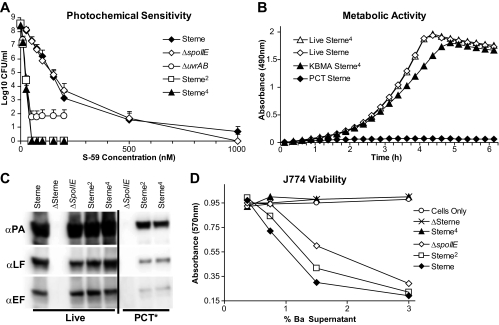FIG. 2.
Increased sensitivity of ΔspoIIE ΔuvrAB strains to photochemical inactivation allows bacteria to retain metabolic activity and secrete critical antigens. (A) ΔspoIIE ΔuvrAB double mutants are exquisitely sensitive to PCT. S-59 was added to mid-log-phase cultures at the indicated concentrations for 1 h at 37°C, and then the cultures were illuminated with 6.5 J/cm2 UVA. The cultures were serially diluted and plated on BHI agar for enumeration of CFU. The symbols represent the mean titers from three independent experiments, and the error bars represent the standard deviations. (B) Photochemically killed ΔspoIIE ΔuvrAB strains retain a high degree of metabolic activity. Sterne or Sterne4 was grown in the presence of 1,000 nM or 50 nM S-59, respectively, for 1 h. The cultures were inactivated by exposure to 6.5 J/cm2 UVA or were not irradiated and then were serially diluted to 5 × 104 CFU per well and assayed for metabolic activity using an MTS assay at 37°C. (C) KBMA B. anthracis secretes critical antigens. Live or photochemically inactivated bacteria were transferred into R medium supplemented with 0.8% sodium bicarbonate to induce anthrax toxin production and incubated for 4.5 h at 37°C. The cell culture supernatants were precipitated with trichloroacetic acid, and culture supernatant equivalents were separated by SDS-PAGE and immunoblotted with anti-PA (αPA), anti-EF, or anti-LF monoclonal antibody. (D) Frozen vegetative cells (1 × 109 CFU) were incubated in R medium with 0.8% sodium bicarbonate for 2 h at 37°C. The culture filtrate was added directly to J774A.1 cell cultures for 3.5 h, at which time a 3-(4,5-dimethyl-2-thiazolyl)-2,5-diphenyl-2H-tetrazolium bromide assay was used to determine the degree of metabolic activity of the cells. The data presented in panels B, C, and D are from representative experiments that were repeated at least twice.

